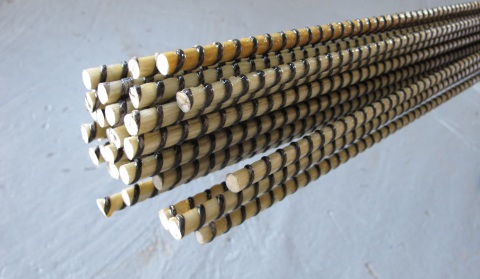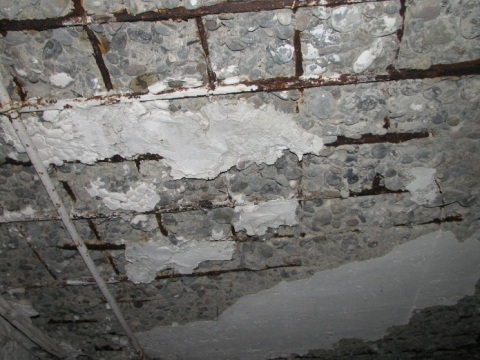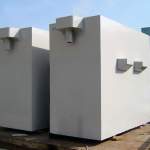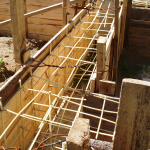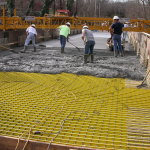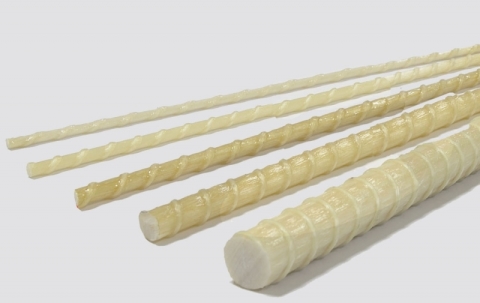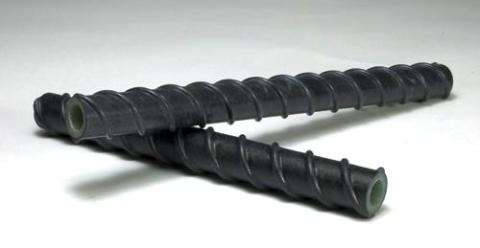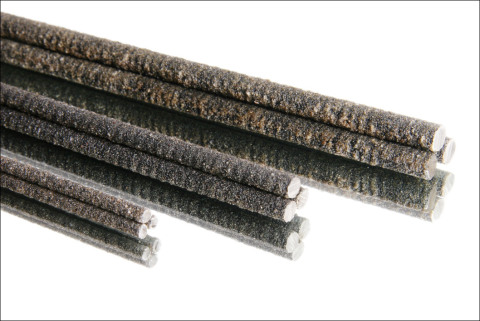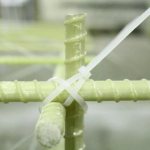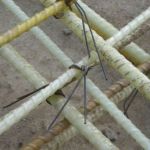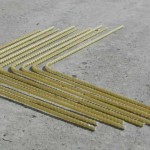Reinforcement made of composite materials - a step into the future
We all know that products and structures made of concrete undergo internal reinforcement, as this significantly increases their strength and crack resistance. Steel rods or wire, perfectly cope with the task assigned to them, but have two drawbacks. The first is the low corrosion resistance of the metal, and the second is its high price.
Reinforcement made on the basis of plastic is two to three times cheaper, has less weight, is not afraid of corrosion, and its strength is quite enough for use in low-rise construction, and not only. Nevertheless, many people do not even suspect about its existence - so we decided to bridge this gap.
The content of the article
Non-metallic reinforcement: the history of appearance and development
As usual, any novelty upon closer examination does not turn out to be at all. Simply, from the moment of the appearance of the first idea, to its implementation and universal recognition, decades often pass. The same story happened with non-metallic fittings, the interest in which in the country arose half a century ago.
So:
- It was associated with the need for the erection of concrete structures, which were to be operated in aggressive conditions. In wet mode - and even when it is not pure water, but any chemical liquids, it is very difficult and expensive to provide corrosion resistance for traditional steel reinforcement.
- Sometimes it also became necessary to create structures with dielectric and antimagnetic properties - for example, during the construction of research institutes, or medical centers in which sensitive equipment was installed.
- In projects where lightweight constructions were to be used with a sufficiently high level of strength, only a combination of high-quality concrete with composite reinforcement could provide these requirements. By the way, concrete itself, when polymer or steel fiber is added to it, can also be considered a composite material.
In addition, in the country, with constantly growing demand for steel, there was a shortage of ore production that could satisfy them, and there was also a lack of additives with which alloying was carried out. It was obvious that the need to create non-metallic reinforcement matured, which prompted the developers, so to speak, to new achievements.
How it all started with us
The first technology for manufacturing reinforcement with a diameter of 6 mm, based on fiberglass with zirconium additives, was developed in the Union in the seventies. Its supporting base was created from a glass seamless alkaline fiber with a diameter of up to 15 microns, the beams of which were combined into rods using synthetic resins.
- Of course, they did not immediately begin to use such reinforcement, but at first they only studied its properties: mechanics, chemical resistance, and durability. According to the results of observations, the composition of the composite improved until it was possible to obtain rods with elastic modulus of 50 thousand MPa and tensile strength of 1.5 thousand MPa.
- Their bending strength was tested by manufacturing prototypes of concrete products made using fiberglass reinforcement and subjected to static loads.The first such products were traverse supports for power lines, which were mounted on experimental sites.
- Based on the results of the experiments, TUs were developed for the manufacture of fiberglass reinforcement, as well as the conditions for the design of concrete structures with its use. In parallel, areas of application of the new material were recommended, which included not only construction, but also the chemical industry and metallurgy.
- For electrolysis baths, the use of non-metallic fittings is very important
- Concrete slabs with composite reinforcement for attaching slopes
- Frame core composite strip base
However, large-scale use of non-metallic reinforcement did not work then. Basically, it began to be used for the manufacture of concrete piles, slopes, structures of overpasses, and the strengthening of some supporting structures.
But in the late 80s, on the basis of fiberglass reinforcement, a 15-meter bridge was built in the Khabarovsk Territory, each of the five beams of which was reinforced with a 24-rod composite beam, plus a typical steel wire bundle. The result was excellent, and the bridge is still functioning today. It was just the beginning ...
And how is it abroad?
If you trace the history of composite reinforcement as a whole, then it originates from the forties of the last century - that is, from the post-war years. Our country then was not up to the creation of new materials, however, in the USA, the composite formula was intensively worked on. In these years, it has already begun to be widely used, because inexpensive materials were simply necessary for a developing economy.
It was in this country that fiberglass reinforcement with a constant cross-section was created, which at first was used only for the manufacture of inventory. A more serious application began already in the 60s, when the composite began to be considered as an alternative to metal reinforcement.
First of all, they began to use it for reinforcing pavings, which, as you know, not only with them, but also with us, are sprinkled with salt to remove ice in the winter. And it spoils not only the wheels of cars, but also, seeping in the form of a solution through the thickness of concrete, corrodes the internal reinforcement.
- Road surfaces sprinkled with salt
- Composite pavement reinforcement
- Construction of a bridge with non-metallic fittings
So:
- It is in this area, the resistance of plastics to corrosion proved to be the best. The only thing that served as an obstacle to the complete replacement of metal with a composite was its high cost, which was only possible to reduce in twenty years. Therefore, at first zinc or epoxy coating was simply applied to the metal.
- But since it turned out that fiberglass reinforcement for polymer concrete is more effective than steel reinforcement - different characteristics of thermal expansion affected, then in 1983, the first document was developed in the United States that regulates the use of composite technologies in the design of bridges.
- Why bridges? Yes, because their poor condition was connected with corrosion of the valves, which worried the services responsible for their operation. Composite reinforcement was then considered the main opportunity to solve this problem.
- Following this, it has already begun to be used for advanced technologies: in the design of laboratories and medical centers stuffed with electronics, airport runways, and even reactors in electrical substations.
- In Japan, widespread use of non-metallic reinforcement began in the mid-nineties. Then they had more than a hundred large projects - mainly commercial, in which fiberglass reinforcement was used. Around the same time, starting from Germany, it began to be used in Europe, as well as Canada.
But the most solid consumer of composite reinforcement, of course, was China.In this country, it was used not only in the construction of bridges, but was also the first to be used for the design of underground and tunnel structures.
What has changed today
All of the above information speaks about the solid advantages of composite reinforcement, and, nevertheless, not only most private traders, but many builders do not know about it. And those who still know, are sometimes skeptical of this material.
To dispel doubts, we will describe in more detail what polymer reinforcement is produced today, in which areas it can be used, and in which not.
Varieties of polymer reinforcement
Today, there are several manufacturing techniques for non-metallic fittings that use different raw materials.
To make the difference more understandable, for clarity, we will present the main types in the form of a table:
| What does the reinforcement look like? | Distinctive features |
| The photo shows fiberglass reinforcement (GFRP-Rebar) - the most common option. Plastic rods up to 12 m long are reinforced with continuous glass fiber. They are made in the range of diameters from 4 to 40 mm. Such reinforcement is used as an alternative to the steel analogue - in structures with unstressed or with prestressed reinforcement. | |
| This type of reinforcement (BFRP) differs from the previous version in that it uses not glass but basalt fiber for reinforcement. It differs not only in color, but also has a higher resistance to aggressive environments. The level of fire resistance is approximately the same, since any polymer can withstand a maximum of +160 degrees. Ideal for foundations and blind areas. | |
| This fixture, referred to by the abbreviation CFRP, is called carbon, because here, in tandem with synthetic thermosetting resins, carbon fiber is used. Unlike the previous options, it can have a sandy finish, which we see in the photo. It is used not only in civil, but also in industrial construction, as well as when laying roads, erecting bridges, sea and communication structures. We emphasize that the tensile strength of such reinforcement is five times higher than that of steel rods of class AIII, and 10 times lighter than it. |
All polymer reinforcement options can be made in the form of cables, rods or profiled rods. Section profile shapes can also be different: hollow, solid, square, round.
The winding of the fibers can also differ, and, as you can see from the pictures, the option of the outer coating. Depending on the diameter and degree of flexibility, the reinforcement can be sold as single rods, or twisted into coils.
Are there any disadvantages?
A lot has been said about the advantages of polymer reinforcement, but its potential user may have a legitimate question: “What are the disadvantages of the material, and where is its use undesirable?”
Here we will answer it in this part of the article:
- There are no perfect materials. Any of them has certain disadvantages, and here it all depends on the application, and the operating conditions of the structures.
- In particular, the polymer is inferior to the same steel in fire resistance, since, being in the thickness of concrete, the plastic begins to melt already from +200 Celsius. The melting point of steel is seven times higher, so in some areas of construction, it can not be replaced with plastic.
- For example, composite reinforcement is not used for the manufacture of floor slabs. Accordingly, the frame elements of prefabricated multi-story buildings, or production workshops with increased fire hazard, are reinforced with steel frames - and it is understandable why.
- But for the foundation, this factor does not matter at all, therefore this type of reinforcement is suitable for any of its types.The assembly process of the foundation frame, from the traditional one is practically the same. The only thing here is to use plastic ties for knitting - although you can also use wire.
- Polymer clamps for frame knitting
- Fiberglass wire frame
- Bent frame elements
- Construction of a greenhouse from flexible polymer reinforcement
- One of the inconveniences is that it is impossible to give the composite reinforcement the desired shape by simple heating. Therefore, if it is necessary to manufacture structures with curved shapes, frame parts for them are made by the manufacturer to order.
- On this, in fact, the list of shortcomings ends. Areas in which the use of composite reinforcement is more preferable are much more than limitations.
- Note that such reinforcement is easy to process, you can cut it with a simple hacksaw, or, with a small diameter, use nippers. In everyday life, in addition to pouring foundations and a blind area, it can be used, for example, for the construction of a greenhouse.
So for private construction, plastic reinforcement is the best option, and even more economical. If you count on a ton, it is more expensive, but if you consider that because of the lighter specific gravity of the rods, there are more of them in quantity, then the benefit is quite tangible.
Tags: concrete